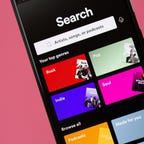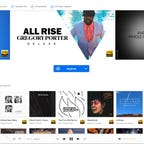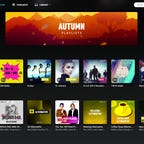Best Music Streaming Service of 2024
The competition between Spotify, Apple Music, Amazon Music and others is hotter than ever. Here are the best streaming services.
Our Picks
Today's music streaming services offer a world of exploration and convenience, giving you access to your favorite artists easily and quickly. Sound quality is even better than ever, as many of the paid subscriptions include spatial Dolby Atmos audio and lossless for free. We've tested all the major services and compared all the relevant features, along with a full price breakdown. Let's dive in.
What is the best music streaming service overall?
When choosing a music streaming service, it's a close race between two services in particular: Spotify Premium and Apple Music. Both cost $11 a month and boast extensive catalogs, so competition is tough, but there is a clear winner. Spotify is the best streaming service for most people. It offers the best mix of features, including great community features such as Spotify Wrapped, audiobooks, plus the excellent Spotify Connect for streaming to all your devices. Spotify also offers the best free tier: Without paying a dime or providing a credit card number, you can listen to millions of tunes and even stream to Wi-Fi devices.
For Apple device users, the excellent Apple Music is hot on Spotify's tail with the potential for better sound due to the inclusion of lossless and spatial music. Although the company has made strides in recent years, a few bricks of the walled garden remain, and it's not as recommendable to Android or PC users. Spotify is still a better choice for users of both iOS and Android. Lastly, if you're an audiophile -- or simply love music -- then both Tidal and Qobuz offer excellent sound quality at a realistic price. Although Tidal has made great strides in removing the proprietary MQA format and reducing its price, Qobuz has a slight edge as it doesn't require a decoder plus it has a download store.
Read more: Apple Music vs. Spotify: Comparing the Top Music Streaming Services
Spotify is a pioneer in music streaming and is arguably the best-known service. It offers several curated music discovery services, including its Discover Weekly playlist, and is constantly implementing new ones, such as Stations, an AI DJ, audiobooks and podcasts.
While it may not be lossless (yet), Spotify is great if you're seeking a solid all-around service, especially one that lets you make, browse and share playlists for any occasion.
It's worth noting that Spotify is undergoing price changes at the moment, which are related to the addition of audiobooks. The company just increased prices in the UK (£12) and Australia (AU$14) and is expected to hike the US cost later in the year.
Best alternative to Spotify
Apple Music
At the same price as Spotify, Apple Music can still offer a lot for the money, including 100 million tracks and iOS and Android compatibility. The service runs second to Spotify in terms of subscribers but surpasses its rival in one key respect. Apple Music has hi-res lossless, spatial audio albums, and a classical music app at no extra charge.
While it makes the most sense if you're an Apple user, Music is an option if you're listening on a PC, or have invested in smart speakers, including those from Google. If you own an Apple HomePod, Mini or Nest device you can summon Apple Music tracks with your voice. There are also a ton of curated playlists, many handcrafted by musicians and tastemakers, although it lacks the robust sharing options (or some of the cool add-ons) available to Spotify.
Best for audiophiles
Qobuz
Qobuz's streaming service offers a wealth of music in hi-res, and you don't need a special hardware decoder to listen to it (unlike competitor Tidal). The service offers two plans: Studio Premier ($13 monthly or $130 yearly) and the $180 annual Sublime Plus. Uniquely, the service offers its own hi-res download store, and if you sign up for Sublime you get a discount on purchases.
At 100 million tracks, Qobuz's streaming catalog rivals Tidal's and Spotify's in number, and based on our tests its catalog of more obscure artists is now pretty impressive. Excellent sound quality at a decent price? Qobuz is our favorite service for serious music lovers.
Top services compared
| Amazon Music Unlimited | Apple Music | Qobuz | Spotify | Tidal | YouTube Music | |
|---|---|---|---|---|---|---|
| Monthly fee | Prime members: $10, £10, $13; Non-Prime members: $11, £11, AU$12; Echo-only service: Free, AU$6 | $11, £11, AU$13; Voice $5, £5, AU$6 | Studio: $13, £13, AU$20; Sublime (per year): $180, £180, AU$250 | $11, £12, AU$14 | $11, £11, AU$12 | $14, £12, AU$12 |
| Free option? | Yes, with ads | No | No | Yes, with ads | Yes | Yes, with ads |
| Free trial period | 90 days | 30 days to 3 months | 30 days | 30 days | 3 months | 30 days |
| Music library size | 100 million | Over 100 million | Over 100 million | Over 100 million | Over 100 million | 100 million |
| Maximum bit rate | 256Kbps, 3,730Kbps (HD) | 256Kbps, 1,152 Kbps (HD estimated) | 6,971Kbps | 320Kbps | 1,411Kbps | 256Kbps |
| Family plan? | Yes, $17, £17, AU$19 for max 6 | Yes, $15, £15, AU$18 for max 6 | Yes, $22, £22, AU$30 | Yes $17, £20, AU$24 per month, max 6 | Yes, HiFi: $15, £15, AU$18 HiFi Plus: $20, £20, AU$24 max 6 | Yes, $17, £15, AU$18 per month for max 6 |
| Student discount | Yes | Yes, Price varies by country | No | Yes, $6, £5 with Hulu and Showtime | Student HiFi: $5, Student HiFi plus: $10 (US only) | Yes, $8 |
| US military discount | No | No | No | No | Yes | No |
| Offline listening | Mobile and desktop | Mobile and desktop | Mobile and desktop | Mobile and desktop | Mobile | Premium, mobile only |
| Radio stations | Yes | Yes | No | Yes | No | Yes |
| Podcasts | Yes | No | No | Yes | Yes | Yes |
| Music videos | No | Yes | No | Yes | Yes | Yes |
| Music locker functionality | No | Yes | No | No | No | Yes |
Best for high-quality streams of rock and urban music
Tidal
After becoming partly owned by Jack Dorsey's Block, Tidal has introduced some very important changes: firstly, it now has the Tidal Free tier, and secondly, it has scrapped its $20 Hi-Fi Plus tier and included everything for $11 instead. It's worth noting that the service is in the process of replacing its proprietary MQA files with hi-res FLAC, although Qobuz still has a slight edge as it doesn't require a specialized decoder at all. If you're an audiophile, a fan of urban music or a mix of both, then Tidal holds plenty of appeal.
Best for Prime members
Amazon Music Unlimited
Amazon Prime Music comes "free" as part of a Prime membership, but users can choose to upgrade to Music Unlimited. At $10 for Prime members, or $11 if you don't have Prime, Unlimited offers an expanded catalog as well as over 1,000 "spatial" remixes. These 360 audio mixes can be played on Dolby Atmos soundbars, Android or iOS devices and the Amazon Echo Studio. In terms of usability, the Music Unlimited interface is also more powerful than before with playlists, genres and podcasts all accessible from the main page.
Best for Android users
YouTube Music
YouTube Music is the successor to Google Play Music, and if you sign up for the ad-free YouTube Premium at $14 per month, you get YouTube Music for free. The good news is that YouTube Music is a mostly impressive service (the lower bit rate of 256kbps is mildly annoying), but Google has retained the predecessor's music locker system enabling users to upload new tracks. In even better news, YouTube Music offers a clean interface plus 100 million tracks to choose from. Instead of playlists, YouTube Music offers well-curated radio stations that play endlessly and are updated often. The added ability to make playlists out of YouTube music clips also makes it a worthy option. If you have a HomePod, you can also now set it to YouTube Music by default.
We also tested
- Deezer: French stalwart Deezer has been operating in the States since 2016, and it has a lot to offer, including a free tier (mobile only) and 90 million tracks. It has more subscribers than some others on this list, thanks in part to its previous affiliation with Cricket Wireless. The main Premium plan is $12 a month, and users are also able to upgrade their audio quality within the app. Deezer also offers a couple of unique features including being the first service enabling users to upload their catalogs from competitors at no extra charge. See at Deezer.
- Napster: Popular music streaming service Rhapsody relaunched as Napster in 2016. It offers 110 million tracks including lossless for $11 a month. The service is fine, although it lacks the killer features of the best here -- e.g. podcasts, simplified streaming and community features. Competition is stiff, and Spotify and Apple are a better value. See at Napster.
- Pandora Premium: Still one of the most popular streaming radio services in the US, Pandora also offers the a la carte Premium ($10 a month) and no-ads Plus ($5 a month). The result is more flexibility than most competitors, and Premium has gained plenty more subscribers in recent years, even if the service is not keeping up in terms of overall catalog size. Sadly, its audio quality is among the lowest available, even on the Premium subscription (192Kbps), and it doesn't offer enough of an incentive for an upgrade from its highly popular free tier. See at Pandora.
Factors to consider
The principal thing you'll need to weigh up is your monthly cost. Until recently, prices were stable at around $10 a month, but Apple Music, Amazon Music Unlimited, Tidal, YouTube Music and Spotify have all hiked rates to $11. At the other end of the spectrum, Tidal is the most expensive at $20 a month.
While your subscription fee can give you access to a number of features -- including classical music, karaoke, podcasts and audiobooks -- what it can also do is unlock higher-quality audio. Sound quality is also an important consideration, and services such as Apple Music and Amazon Music Unlimited offer lossless and Dolby Atmos music at no extra charge. Meanwhile, Spotify is still stuck at relatively low 320kbps, and a planned lossless Supremium tier is MIA -- though it's still rumored to appear in 2024.
If you like to buy your own digital music, Apple Music and YouTube Music are the only services to offer a digital locker to store your own library of songs.
How we chose
We've checked out the big names, including Spotify, Apple Music, Amazon Music and YouTube Music, as well as smaller ones such as Tidal, Qobuz, Napster, Deezer and Pandora Premium, to see how each platform stacks up for your subscription dollar. Most of the services feature music catalogs of around 100 million tracks and are supported by a host of different devices.
Given that all of the services basically have the same libraries, we evaluated each one based on:
- Ease of use.
- Cost.
- Features.
- Sound quality.
While Spotify offers objectively the "worst" quality based on numbers alone, most people won't notice a difference, especially on phones or Bluetooth speakers. The biggest boons for Spotify users are the service's ubiquity, community features and ability to easily pair with other devices.
Apple also gets high marks due to its suitability for iOS and Mac users, as well as the ability to listen to higher-quality streams at no extra cost. If the service was more yielding to PC users and smart home fans, Apple Music would easily become the service we would recommend. In short, Spotify is better for users of almost any phone, smart device or computer.






